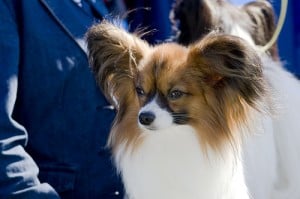From the desk of Sharda Baker.
Hi and Welcome Everyone!
This is Sharda with Papillon newsletter!
Join me in a nostalgic journey back at the Papillon Dog History and its early beginnings!
Let’s start!
The Papillon (pah-pee-yown) breed originates back to the early 16th century, making it one of the oldest toy breeds in recorded history.
Although there are many theories as to the origin of the Papillon, it is believed that they were originally from Western Europe (in Italy or Spain) and that those countries played a very big part in making the Papillon popular.
Many hundred years ago Belgium and France both claim that they were equally responsible for the refining and perfecting of this breed.
The precise country of origin of the Papillon Dog is very difficult to trace.
The Royal Toy Spaniel, Continental Toy Spaniel and Papillon were all bred as companion or “lap” dogs, and the history of these were almost impossible to separate in the very early years.
Nobility favored toy dogs and could afford to breed them specifically for leisure pursuits. Toy dogs were bred to be ornamental and dainty, with loving and faithful personalities – while hunting dogs were bred to work and serve their masters.
It is thought that both Marie Antoinette and Madame de Pompadour helped the Papillon become fashionable and they both admired and owned this breed.
Madame de Pompadour was the mistress of King Louis XIV, and owned Inez and Mimi which were her two pet Papillons.
Marie Antoinette had a Sevres porcelain model of a Phalene (Papillon with drop ears) in her room that was only found after her death.
She was beheaded at the guillotine and her two pet Papillons were looked after by the inhabitants of the house until they died.
Her house in Paris, France is known today as ‘The House of the Papillon’.
Over the centuries, the tiny Papillon has been far luckier than many of the Royal Families that owned them!
In Europe the ruling families knew about Papillons but this breed was not introduced into Great Britain until 1905 and not recognized by the A.K.C. until 1915.
Despite how popular they were among the Royalty and titled of Europe, they were very slow to be embraced by the English speaking people.
The Name
The name Papillon means ‘butterfly’ in French. The name was developed as the breed acquired its distinctive large, luxurious, erect ears which are fringed with very long hair that resemble the wings of a beautiful butterfly.
Running down the top of this dog’s head is a white blaze that adds to its butterfly appearance. The Papillon dogs were always found in portraits of ladies of the French court, as they would never feel a portrait was complete without their faithful little dog somewhere in their picture.
Over the centuries the Papillon has had many different names. Some of the more common ones are:
- Belgian Toy Spaniels
- Dwarf or Continental Toy Spaniels
- Dwarf Spaniel
- Epagneuls Nains
- Little Squirrel Dogs or Squirrel Spaniels
Because of their tails that were heavily plumed and carried the same way as a squirrel’s tail is carried over his back, they were known as Squirrel Spaniels.
Both the erect ears and drop eared dogs can appear in the same litter, but the Papillon with drop ears are called Palene Papillon (Moth).
Today the Papillon is mostly white or parti-coloured with coloured markings, but the early dogs were very often solid-coloured.
The liver Papillon which were once very common are now very seldom in evidence.
That’s it for today.
Hope you learned something.
I’ll be back for more about Papillons.
Until then!
All the best and take care.
Warmly,
Sharda Baker

